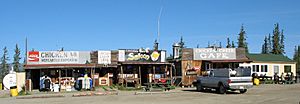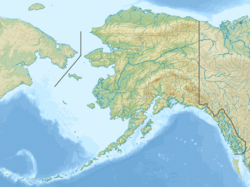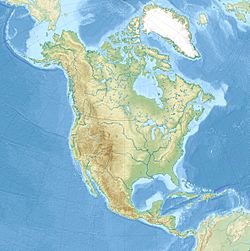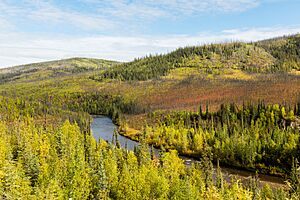Chicken, Alaska facts for kids
Quick facts for kids
Chicken, Alaska
|
|
|---|---|

Downtown Chicken in 2006
|
|
| Country | United States |
| State | Alaska |
| Census Area | Southeast Fairbanks |
| Area | |
| • Total | 115.95 sq mi (300.32 km2) |
| • Land | 115.95 sq mi (300.32 km2) |
| • Water | 0.00 sq mi (0.00 km2) |
| Elevation | 1,677 ft (511 m) |
| Population
(2020)
|
|
| • Total | 12 |
| • Density | 0.10/sq mi (0.04/km2) |
| Time zone | UTC-9 (Alaska (AKST)) |
| • Summer (DST) | UTC-8 (AKDT) |
| ZIP code |
99732
|
| Area code(s) | 907 |
| FIPS code | 02-13450 |
| GNIS feature ID | 1400245 |
Chicken is a very small village in Southeast Fairbanks Census Area, Alaska. It started because of gold mining and is one of the few towns left from the old Alaska gold rush days.
Only about 12 people live in Chicken year-round, based on the 2020 United States census. However, more people come to Chicken during the summer, especially for gold mining. Chicken is also famous for its funny or unusual name.
In Chicken, you can find a cafe with a gas station, a small hotel, a place for RVs, a small general store, and a saloon.
Contents
History of Chicken, Alaska
Chicken was first settled by gold miners in the late 1800s. In 1902, the town needed a name for its new post office. People suggested naming it "Ptarmigan" because there were many of these birds in the area. However, they couldn't agree on how to spell "Ptarmigan," so they chose "Chicken" instead to avoid any embarrassment.
This story about the name is probably not true. It became popular much later, almost 50 years after the town began. The real reason for the name likely comes from a nearby stream called Chicken Creek. In 1896, a person named Josiah Edward Spurr wrote that the creek was named for the size of the gold found there, which was "about that of chicken feed (corn)."
Some of the old buildings in Chicken from the early 1900s, along with a huge old gold-mining machine called the F.E. Company Dredge No. 4 (also known as Pedro Dredge), are on a special list called the National Register of Historic Places. This means they are important historical sites. Chicken is the main outpost for the 40-Mile mining district. People still dig for gold here, and you can also see old, unused gold-digging machines. So much gold was found here that it was worth bringing these giant machines to this remote spot.
In September 2021, the fast-food company Jack in the Box ran an ad campaign. They joked that they had "bought" the town of Chicken for 10,000 chicken sandwiches and a special hat. The company later explained that it was just an ad. However, they did donate $10,000 to help the town during the pandemic. Around that time, the main part of downtown Chicken was actually for sale. This included the Chicken Creek Cafe, the Chicken Creek Saloon, a liquor store, a gas station, the Chicken Mercantile Emporium, and a house.
Geography and Location
The area of Chicken is about 115 square miles (300 square kilometers), and it's all land.
You can reach Chicken by air through Chicken Airport. You can also drive there using Alaska Route 5, which is part of the Taylor Highway. However, this road is not kept clear from mid-October to mid-March, so it's hard to get there in winter.
Chicken's Climate and Weather
Chicken has a very cold climate with dry winters. It has extremely cold and long winters and warm, short summers. The average temperature in Chicken is about 20.2°F (‑6.6°C). July is the warmest month, averaging 56.1°F (13.4°C), and January is the coldest, averaging ‑20.0°F (‑28.9°C).
Even though Chicken is located far north, it doesn't get much warm wind. So, the temperature in January has never gone above 32°F (0°C). Even in the hottest months like June and July, nights can be cold enough for frost. The temperatures in Chicken have ranged from a super cold ‑72°F (‑58°C) to a hot 91°F (33°C). The coldest temperature ever recorded in the United States in December was in Chicken.
| Climate data for Chicken, Alaska, 1991–2020, extremes 1953–present | |||||||||||||
|---|---|---|---|---|---|---|---|---|---|---|---|---|---|
| Month | Jan | Feb | Mar | Apr | May | Jun | Jul | Aug | Sep | Oct | Nov | Dec | Year |
| Record high °F (°C) | 31 (−1) |
43 (6) |
54 (12) |
75 (24) |
84 (29) |
90 (32) |
91 (33) |
87 (31) |
72 (22) |
64 (18) |
35 (2) |
32 (0) |
91 (33) |
| Mean maximum °F (°C) | 15.2 (−9.3) |
24.1 (−4.4) |
41.7 (5.4) |
57.8 (14.3) |
74.5 (23.6) |
81.8 (27.7) |
82.4 (28.0) |
79.0 (26.1) |
66.1 (18.9) |
49.2 (9.6) |
23.7 (−4.6) |
18.9 (−7.3) |
84.3 (29.1) |
| Mean daily maximum °F (°C) | −11.4 (−24.1) |
0.6 (−17.4) |
20.3 (−6.5) |
42.4 (5.8) |
58.2 (14.6) |
68.5 (20.3) |
70.2 (21.2) |
64.3 (17.9) |
52.7 (11.5) |
30.5 (−0.8) |
3.5 (−15.8) |
−7.0 (−21.7) |
32.7 (0.4) |
| Daily mean °F (°C) | −20.0 (−28.9) |
−10.6 (−23.7) |
3.4 (−15.9) |
27.1 (−2.7) |
43.8 (6.6) |
53.3 (11.8) |
56.1 (13.4) |
50.3 (10.2) |
39.3 (4.1) |
20.0 (−6.7) |
−5.3 (−20.7) |
−14.9 (−26.1) |
20.2 (−6.6) |
| Mean daily minimum °F (°C) | −28.6 (−33.7) |
−21.9 (−29.9) |
−13.6 (−25.3) |
11.7 (−11.3) |
29.3 (−1.5) |
38.2 (3.4) |
42.0 (5.6) |
36.3 (2.4) |
25.9 (−3.4) |
9.5 (−12.5) |
−14.2 (−25.7) |
−22.9 (−30.5) |
7.6 (−13.6) |
| Mean minimum °F (°C) | −58.7 (−50.4) |
−47.7 (−44.3) |
−37.4 (−38.6) |
−12.4 (−24.7) |
16.3 (−8.7) |
27.1 (−2.7) |
31.3 (−0.4) |
23.7 (−4.6) |
10.9 (−11.7) |
−12.5 (−24.7) |
−36.9 (−38.3) |
−47.3 (−44.1) |
−61.2 (−51.8) |
| Record low °F (°C) | −72 (−58) |
−72 (−58) |
−58 (−50) |
−32 (−36) |
5 (−15) |
15 (−9) |
24 (−4) |
19 (−7) |
−7 (−22) |
−39 (−39) |
−52 (−47) |
−72 (−58) |
−72 (−58) |
| Average precipitation inches (mm) | 0.36 (9.1) |
0.25 (6.4) |
0.25 (6.4) |
0.30 (7.6) |
1.04 (26) |
2.40 (61) |
2.84 (72) |
2.01 (51) |
1.10 (28) |
0.64 (16) |
0.59 (15) |
0.49 (12) |
12.27 (312) |
| Average snowfall inches (cm) | 5.7 (14) |
2.6 (6.6) |
2.7 (6.9) |
2.3 (5.8) |
1.0 (2.5) |
0.0 (0.0) |
0.0 (0.0) |
0.0 (0.0) |
1.1 (2.8) |
6.1 (15) |
7.9 (20) |
7.2 (18) |
36.6 (93) |
| Average precipitation days (≥ 0.01 in) | 3.4 | 2.0 | 1.5 | 1.8 | 5.0 | 8.4 | 10.9 | 9.7 | 6.1 | 4.1 | 4.2 | 3.8 | 60.9 |
| Average snowy days (≥ 0.1 in) | 4.1 | 2.3 | 1.9 | 1.5 | 0.5 | 0.0 | 0.0 | 0.0 | 1.1 | 4.3 | 5.0 | 4.4 | 25.1 |
| Source 1: NOAA | |||||||||||||
| Source 2: WRCC | |||||||||||||
Population of Chicken
| Historical population | |||
|---|---|---|---|
| Census | Pop. | %± | |
| 1930 | 20 | — | |
| 1940 | 41 | 105.0% | |
| 1950 | 34 | −17.1% | |
| 1980 | 37 | — | |
| 2000 | 17 | — | |
| 2010 | 7 | −58.8% | |
| 2020 | 12 | 71.4% | |
| U.S. Decennial Census | |||
Chicken first appeared on the U.S. Census in 1930 as a small village. It was counted again in 1940 and 1950. Then, it wasn't listed again until 1980. At that time, the Census Bureau decided to make Chicken the name for a larger "census-designated place" (CDP). This means the population count included not just the village but also the surrounding area.
After 1980, the CDP was removed for ten years, and the village's population wasn't published in 1990. But in 2000, the CDP was brought back. So, the population numbers for Chicken from 2000 onwards include everyone living in the larger CDP area, not just the tiny village itself.
Chicken in Books
Chicken, Alaska, has been featured in a few books:
- The book Tisha: The Story of a Young Teacher in the Alaskan Wilderness by Robert Specht is about a young teacher named Anne Hobbs who taught in Chicken during the 1920s.
- In the short story The Red Convertible by Louise Erdrich, two characters, Henry and Lyman, take a road trip from Montana all the way to Chicken, Alaska.
See also
 In Spanish: Chicken (Alaska) para niños
In Spanish: Chicken (Alaska) para niños





